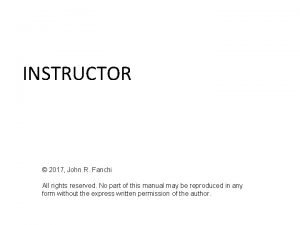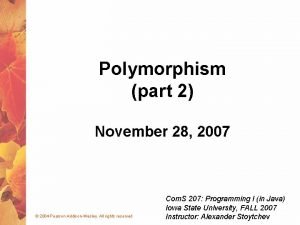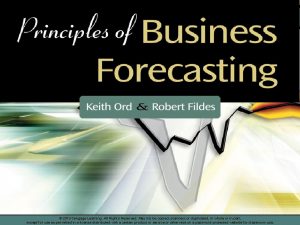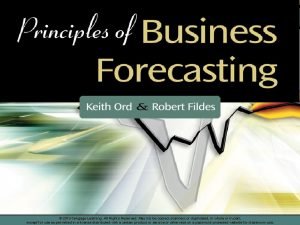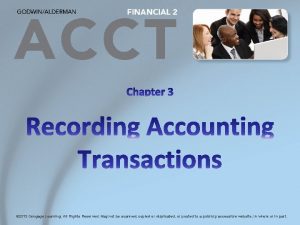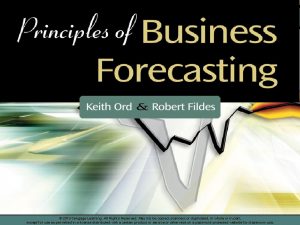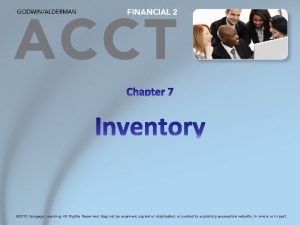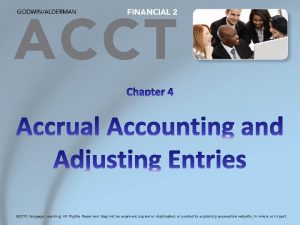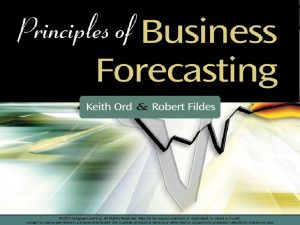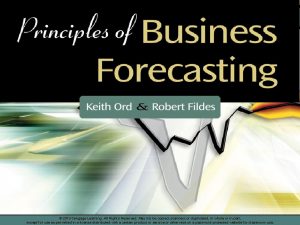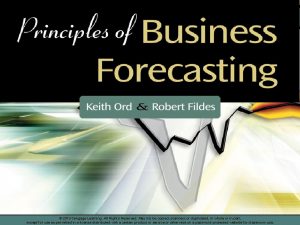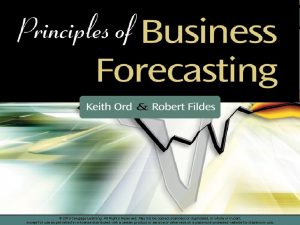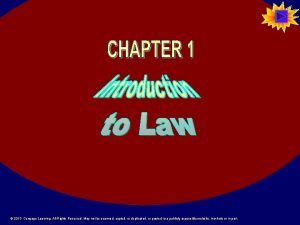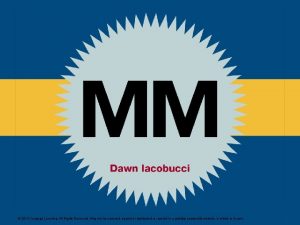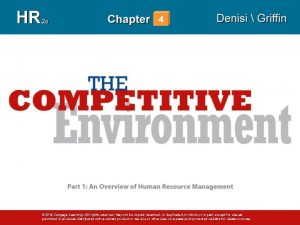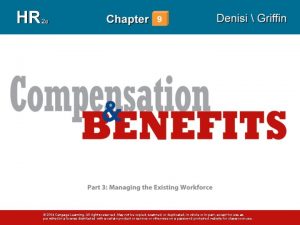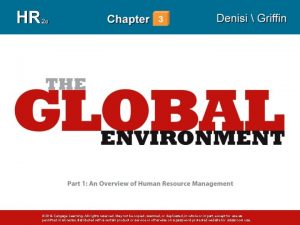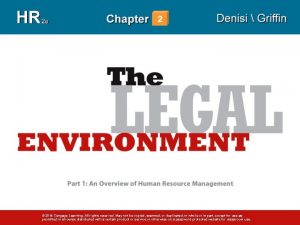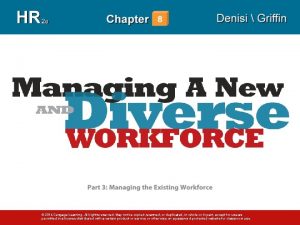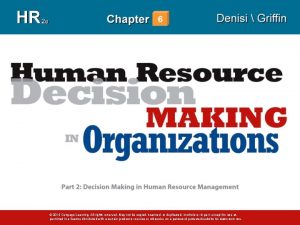2013 Cengage Learning All Rights Reserved May not



































- Slides: 35

© 2013 Cengage Learning. All Rights Reserved. May not be scanned, copied or duplicated, or posted to a publicly accessible website, in whole or in part.

Learning Objectives 1. Describe the four assumptions made when communicating accounting information. 2. Describe the purpose and structure of an income statement and the terms and principles used to create it. 3. Describe the purpose and structure of a balance sheet and the terms and principles used to create it.

Learning Objectives 4. Describe the purpose and structure of a statement of retained earnings and how it links the income statement and the balance sheet. 5. Describe the purpose and structure of a statement of cash flows and the terms and principles used to create it.

Learning Objectives 6. Describe the qualitative characteristics that make accounting information useful. 7. Describe the conceptual framework of accounting.

LOI Beginning Assumptions Accounting is the process of identifying, measuring, and communicating economic information to permit informed judgments and decisions. Put more simply, accounting is the “language of business. ”

The Assumptions The assumptions to accomplish the process of accounting are: • Economic Entity 1 • This assumption states that the financial activities of a business can be separated from the financial activities of the business’s owner. • Time Period 2 • Accountants assume that economic information can be meaningfully captured and communicated over short periods of time. • Monetary Unit 3 • Accountants assume that the dollar is the most effective means to communicate economic activity. • Going Concern 4 • Accountants assume that a company will continue to operate into the foreseeable future.

LO 2 Reporting Profitability: The Income Statement ? One of the first questions any business wants to know is whether they are making money or are profitable. These answers can be found in the Income Statement.

The Income Statement and Terms An income statement reports a company’s revenues and expenses. Matching principle – Expenses should be recorded in the period resources are used to generate revenues Revenue – An increase in resources resulting from the sale of goods or services Terms Expense – A decrease in resources resulting from the sale of goods or services Revenue recognition principle – A revenue should be recorded when a resource has been earned

Basic Structure of the Income Statement Revenues – Expenses = Net Income or Net Loss Reported over a specific period, like for the year ended December 31, 2012

Income Statement Example Exhibit 1 -1

LO 3 Reporting Financial Position: The Balance Sheet ? An important issue for any business is its current financial position. What does the business own? What does it owe? These answers can be found in the Balance Sheet.

Reporting Financial Position: The Balance Sheet and Related Terms Asset: An economic resource that is objectively measurable, that results from a transaction, and that will provide future economic benefit. Cost principle: The principle that assets should be recorded and reported at the cost paid to acquire them. Liability: An obligation of a business that results from a past transaction and will require the sacrifice of economic resources at some future date. Equity: The difference between a company’s assets and liabilities and represents the share of assets that are claimed by the company’s owners. Contributed capital: The resources that investors contribute to a business in exchange for an ownership interest. Retained earnings: Profits generated through operations that are retained in the business.

Basic Structure of the Balance Sheet ACCOUNTING EQUATION Assets = Liabilities + Equity Reported at a given time or date

Balance Sheet Example Exhibit 1 -2

LO 4 Reporting Equity: The Statement of Retained Earnings A statement of retained earnings shows the change in a company’s retained earnings over a specific period of time.

Basic Structure of the Statement of Retained Earnings

Statement of Retained Earnings Example Exhibit 1 -3

Relationship Among Financial Statements The Statement of Retained Earnings links the income statement and the balance sheet.

LO 5 Reporting Cash Flows: The Statement of Cash Flows ? A business needs to answer questions about the management of cash: • Where does a company get its cash? • Where does its cash go? • Will there be enough cash to pay bills? These answers can be found in the Statement of Cash Flows.

Reporting Cash Flows: The Statement of Cash Flows The details of cash inflows and outflows for a business are reported on a statement of cash flows in the following three sections: Operating Activities Investing Activities Financing Activities

Basic Structure of the Statement of Cash Flows

Statement of Cash Flows Example – Exhibit 1 -5

LO 6 Qualitative Characteristics of Accounting Information Understandability The ability of accounting information to “be comprehensible to those who have a reasonable understanding of business…and are willing to study the information with reasonable diligence. ” Relevance The capacity of accounting information to make a difference in decisions. Reliability The extent to which accounting information can be depended upon to represent what it purports to represent, both in description and in number. Comparability The ability to use accounting information to compare or contrast the financial activities of different companies.

Qualitative Characteristics (Continued) Consistency The ability to use accounting information to compare or contrast the financial activities of the same entity over time. Materiality The threshold at which a financial item begins to affect decision making. Conservatism The manner in which accountants deal with uncertainty regarding economic situations.

LO 7 The Conceptual Framework The grammar or terms, explaining financial accounting language in this chapter, are more formally known as components of the conceptual framework of accounting. The conceptual framework of accounting is the collection of concepts that guide the manner in which accounting is practiced.

Terms Used to Identify and Describe Economic Information Term Definition Reported on the Asset A resource of a business Balance sheet Liability An obligation of a business Balance sheet Equity The difference between assets and liabilities Balance sheet Contributed Capital Equity resulting from contributions from owners Balance sheet Retained Earnings Equity resulting from profitable operations Balance sheet and statement of retained earnings Revenue An increase in assets resulting from selling a good or providing a service Income Statement Expense A decrease in assets resulting from selling a good or providing a service Income Statement Dividend A distribution of profits to owners Statement of retained earnings

Principles Used to Measure Economic Information Principle Definition Ramification Revenue recognition Revenues are The receipt of cash recorded when they is not required to are earned. record a revenue. Matching Expenses are recorded in the time period when they are incurred to generate revenues. Cost Assets are recorded Except in a few and maintained at cases, market their historical costs. values are not used for reporting asset values. For many assets, the cost of the asset must be spread over the periods that it is used.

Assumptions Made When Communicating Economic Information Assumption Definition Ramification Economic entity The financial activities of a business can be accounted for separately from the business's owners. We do not have to worry that the financial information of the owner is mixed with the financial information of the business. Monetary unit The dollar, unadjusted for All transactions in foreign inflation, is the best means currencies are converted to of communicating dollars. accounting information in the United States. Time period Accounting information can be communicated effectively over short periods of time. Most businesses prepare quarterly and annual financial statements. Going concern The company for which we are accounting will continue its operations indefinitely. If an entity is not selling its assets, then the cost principle is appropriate.

Qualitative Characteristics of Accounting Information Term Definition Ramification Understandability Accounting information should be comprehensible by those willing to spend a reasonable amount of time studying it. Users must spend a reasonable amount of time studying accounting information for it to be understandable. Relevance The capacity of accounting information to make a difference in decisions. Information should have predictive or feedback value and should be timely.

Qualitative Characteristics of Accounting Information (continued) Term Definition Ramification Reliability The extent to which accounting information can be depended upon to represent what it purports to represent, both in description and in number. Information should be free from error, a faithful representation, and neutral. Comparability The ability to use accounting information to compare or contrast the financial activities of different companies. Entities must disclose the accounting methods that they use so that comparisons across companies can be made.

Qualitative Characteristics of Accounting Information (Continued) Terms Definition Ramifications Consistency Accounting information should be comparable across different time periods within a company. An entity should use the same accounting methods year to year and disclose when they change methods. Materiality The threshold over which an item could begin to affect decisions. When an amount is small enough, normal accounting procedures are not always followed.

Qualitative Characteristics of Accounting Information (Continued) Terms Definition Ramifications Conservatism When uncertainty exists, accounting information should present the least optimistic alternative. An entity should choose accounting techniques that guard against overstating revenues or assets.

Financial Statements Used to Communicate Economic Information Statement Purpose Structure Links to Other Statements Balance sheet Shows a company’s assets, liabilities, and equity at a specific point in time. Assets = Liabilities The balance in retained + Equity earnings comes from the statement of retained earnings. The balance in cash should agree with the ending cash balance on the statement of cash flows. Income statement Shows a company’s revenues and expenses over a specific period of time. Revenue Expenses = Net Income/ Loss Net income/loss goes to the statement of retained earnings to compute retained earnings.

Financial Statements Used to Communicate Economic Information (continued) Statement Purpose Structure Links to Other Statements Statement of retained earnings Shows the changes in a company’s retained earnings over a specific period of time. Beginning Ending retained Retained Earnings earnings goes to the +/- Net balance sheet. Income/Loss Dividends = Ending Retained Earnings Statement of cash flows Shows a company’s inflows and outflows of cash over a specific period of time. Operating Cash Flows +/Investing Cash Flows +/Financing Cash Flows = Net change in cash The ending cash balance on the statement of cash flows should agree with the balance in cash on the balance sheet.

End of Chapter 1
 Solomon four group design
Solomon four group design Specification by example
Specification by example Copyright 2015 all rights reserved
Copyright 2015 all rights reserved All rights reserved sentence
All rights reserved sentence Creative commons vs all rights reserved
Creative commons vs all rights reserved Confidential all rights reserved
Confidential all rights reserved Sentinel-controlled repetition
Sentinel-controlled repetition Copyright 2015 all rights reserved
Copyright 2015 all rights reserved Pearson education inc all rights reserved
Pearson education inc all rights reserved Microsoft corporation. all rights reserved.
Microsoft corporation. all rights reserved. Microsoft corporation. all rights reserved.
Microsoft corporation. all rights reserved. Microsoft corporation. all rights reserved.
Microsoft corporation. all rights reserved. Pearson education inc. all rights reserved
Pearson education inc. all rights reserved Dell all rights reserved copyright 2009
Dell all rights reserved copyright 2009 Warning all rights reserved
Warning all rights reserved C all rights reserved
C all rights reserved All rights reserved formula
All rights reserved formula Warning all rights reserved
Warning all rights reserved Confidential all rights reserved
Confidential all rights reserved Microsoft corporation. all rights reserved
Microsoft corporation. all rights reserved 2010 pearson education inc
2010 pearson education inc Copyright © 2018 all rights reserved
Copyright © 2018 all rights reserved Gssllc
Gssllc Copyright 2010 pearson education inc
Copyright 2010 pearson education inc Pearson education inc. all rights reserved
Pearson education inc. all rights reserved Confidential all rights reserved
Confidential all rights reserved Airbus deutschland gmbh
Airbus deutschland gmbh R rights reserved
R rights reserved Rights reserved
Rights reserved Hci patterns
Hci patterns Chapter 6:2 interpreting word parts
Chapter 6:2 interpreting word parts Medical terminology chapter 5 learning exercises answers
Medical terminology chapter 5 learning exercises answers Cengage learning heart diagram
Cengage learning heart diagram South-western cengage learning
South-western cengage learning Chapter 13 medical math assignment sheet
Chapter 13 medical math assignment sheet 2009 delmar cengage learning
2009 delmar cengage learning



























